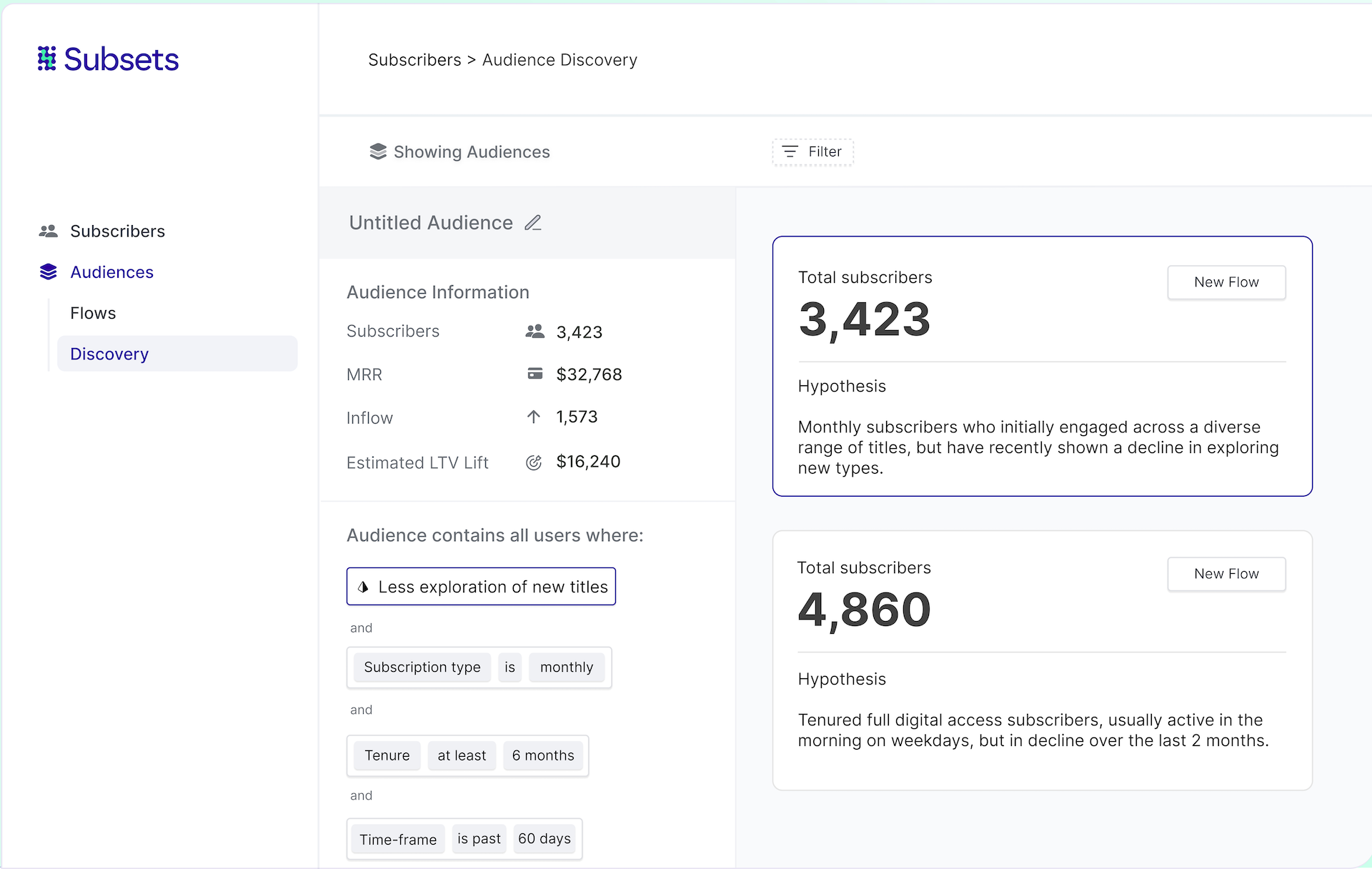Subsets helps subscription businesses reduce churn with ‘retention experiments’ and explainable AI
Recurring revenue is pretty much the holy grail for any business — it’s precisely why Apple has segued towards being almost as much a services company as it is a hardware company, with 20% of its revenue now emanating from Apple TV+, Apple Music, iCloud, among an array of other subscription and non-subscription-based services.
The cost of acquiring new customers has also reportedly increased by more than 200% over the past decade, which highlights the importance of predictable revenue streams. But there are inherent challenges with subscription-based business models — not only must companies focus on growing the number of people willing to pay for a given service, but they must also be mindful of retaining those that they already have. Reducing churn is the name of the game.
This is something that fledgling Danish startup Subsets is setting out to help companies achieve, with an AI-enabled platform designed to “bridge the retention gap in the subscription industry.”
Explainable
Founded out of Copenhagen in 2022, Subsets leans on so-called “explainable AI” to tell companies which current subscribers might be about to jump ship, and serves up “experiments” to find the best way of enticing them to stay.
Explainable AI is a concept that describes AI’s ability to “explain” or justify any decisions and insights it provides in a way that humans can parse, and it has emerged as one of the cornerstones of a wider societal push to make AI more trustworthy — most of the major large language model (LLM) providers are trying to appease critics by addressing the much-maligned “black box” problem.
Six months on from its launch, Subsets has already claimed some decent customers including the New York Times’-owned Athletic and Danish newspaper Børsen. But the company is now looking to double down on this recent traction with a fresh $1.65 million in pre-seed funding led by Nordic early-stage VC Upfin and Y Combinator (YC), following Subsets’ participation in YC’s Summer ’23 program.
The media business
While Subsets could be applied to any subscription business, it’s currently focused on the digital media vertical.
“We are limiting our use case to digital media at the moment — this includes digital publishers, streaming [platforms], subscription apps, and telecoms,” Subsets co-founder and CEO Martin Johnsen told TechCrunch. “Subsets can be applied more broadly across digital consumer subscriptions later — I see us broadening into, for example, mobility, banking, and food delivery. Even more offline subscription categories, as everything becomes more digital.”
Companies connect Subsets to their various internal systems, such as CRM (customer relationship management), CMS (content management system), billing, data warehouse, and so on to garner subscriber data points — this can include things like demographics, how each subscriber consumes a specific piece of content (e.g. times, category preferences), and any other relevant items related to the product and how the customer interacts with it.
On the front end, Subsets serves a web app through which commercial teams can delve into the “churn audiences” via easy-to-understand visuals and natural language. For example, it might highlight thousands of subscribers who used to engage across myriad different titles under a particular media brand, but are now showing signs of losing interest.

Subsets: Audience discovery Image Credits: Subsets
Subsets allows non-technical teams to run retention “experiments” on subsets (hence the company name) of their subscriber base, to see what actions might lead a customer to staying on-board. These experiments might be a series of push notifications or email offering a subscription discount, or perhaps a free upgrade to unlock new features. The specifics of these “retention flows” can be tweaked by each customer.

Subsets: Experiment Image Credits: Subsets
Whatever steps are found to have reduced churn in the experimentation phase are presented in the form of results that showcase what worked — it’s designed to take at least some of the guesswork out of a company’s retention endeavors, and allows the company to “automate what works.”
“Some of these experiments will yield very good results on subscriber retention — the experiments that yield good results are automated,” Johnsen said. “Because an audience is defined by a specific subscriber behavior which triggers churns, these audiences are typically dynamic, and new subscribers will flow in and out of an audience. All the subscribers flowing into an audience receive the flows that have proven to yield good results.”

Subsets: Results Image Credits: Subsets
Connections
With a mathematic modelling and computation education background, Johnsen tells TechCrunch that the company has developed its own AI algorithms using “gradient-boosting models with temporal sequencing methods.” Gradient-boosting essentially combines multiple “weak” predictive models to create a single stronger predictive model, while temporal sequencing incorporates time-related features into the modelling process. Subsets then uses frameworks from Elon Musk’s xAI to make “churn-driving behavior understandable,” as Johnsen puts it.
While Subsets doesn’t use any of OpenAI’s GPT.x models at present, Johnsen said that they are working on building some additional “downstream functionality” into its product using the same foundational model that powers ChatGPT.
In a social media post this week, YC president and CEO Garry Tan said that around half of all YC companies “are using LLMs in some way,” which certainly aligns with its latest investment in Subsets. Securing YC as an early backer is also proving fruitful for Subsets’ growth plans given YC’s historical connections — indeed, Subsets’ customer the Athletic is also a YC alum, graduating from the Summer ’16 program six years before it was bought by the New York Times.
“YC has an impressively strong network, which has given us some exciting opportunities,” Johnsen said.
Aside from lead backers Upfin and YC, Subsets’ pre-seed round included investments from a slew of institutional and angel investors including Cuesta Labs; Sandhill Markets; and Peakon founder Phillip Chambers.


